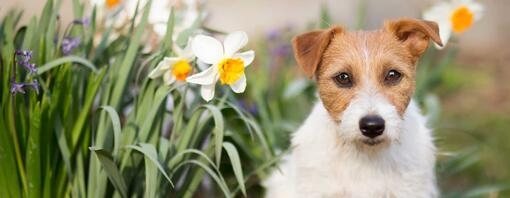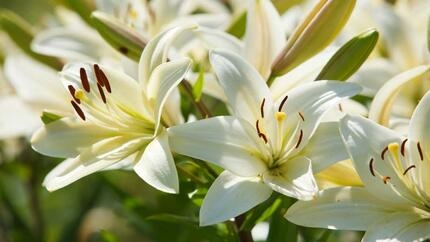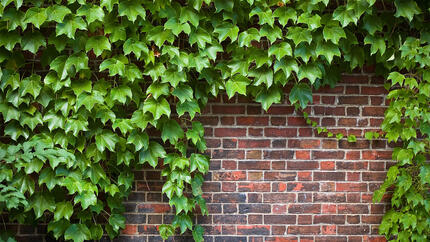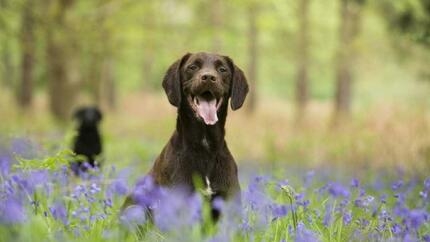Are Daffodils Poisonous to Dogs? The Signs to Look Out For!

Spring certainly knows how to make an entrance. Blue skies, green gardens, colourful flowers and longer days entice all of us, owners and dogs, out of the house. But all this fun outdoor exploration might make owners nervous about the potential risks that spring plants pose to dogs. In this article, we’re exploring the springtime favourites: the breathtaking daffodils.
Keep reading to find out if daffodils are poisonous to dogs and what signs to look out for if you suspect your pet has been in close contact with this flower.
How to identify daffodils?
You’ll have no trouble identifying these lovely flowers. Daffodils are trumpet-shaped flowers, with usually white or yellow petals, that come with an orange central corona.
The leaves are long and flat. You will see these bright flowers in full bloom between March and late April, so pay particular attention on your dog walks during that time of year.
Are daffodils poisonous to dogs?
Yes, daffodils are poisonous to dogs and you should keep them away from your pet. These plants contain a toxic component called lycorine which can cause digestive upset when ingested. There are other substances in a daffodil flower that might also cause irritation to the skin and to the mouth and throat if ingested. So, the best thing is for your dog to avoid close contact with this flower.
If you suspect your dog has ingested daffodils, contact the vet immediately.
Are daffodil bulbs poisonous to dogs?
Daffodils are not only dangerous to dogs when they’re in full bloom. The bulbs also contain the substance lycorine which is the toxic component leading to health problems when ingested. In fact, the daffodil bulbs have a higher concentration of this compound than the flower itself, so if your dog is a relentless digger, keep this in mind. Many dogs who wouldn’t dream of nibbling flowers can be far more interested in having a chew on interesting looking objects they dig up. This can be a problem all year round and many daffodil bulbs are left in the ground year after year so as to make a stunning spring display of colour.
Signs of daffodil poisoning in dogs
If you suspect your dog has consumed parts of daffodil flowers, keep a close eye on them for the next few hours and don’t hesitate to contact the vet. Here are some of the symptoms you might notice:
Diarrhoea
Vomiting
Abdominal pain
Drooling
Trembling
Lethargy
Skin irritation
What to do if your dog has eaten daffodil flowers or bulbs?
The first thing to do is remove any flowers or bulbs from your dog’s mouth and call your vet immediately. Sometimes the vet might advise a simple solution such as giving your dog a bowl of milk or water. But in more severe situations, you will be asked to bring the dog to the vet immediately. As always, it is important to avoid administering any treatment at home without consulting the vet. Call them for advice as soon as possible.
As always when your dog eats any plant life that you can’t identify or are not sure about, don’t forget to take a picture of the plant and show it to the vet. This will help them identify the toxic component that might be in the pet’s system and recommend the best treatment. Even better yet, take a few samples and bring them to your vet so they can determine the level of risk they pose for the dog.
How to keep dogs away from daffodils?
It might seem impossible to eliminate any interaction your dog may have with these spring flowers considering they are such popular additions to people’s gardens and in parks. But here are a few things you can do to prevent daffodil poisoning affecting your dog:
- Do not grow daffodils in your own garden – or the parts of the garden your dog has access to, and if you have grown them in the past, turn the earth over to make sure all bulbs are removed. If you can’t imagine spring without daffodils in your garden, fence them off so your dog can’t get access.
- In spring, keep your dog in sight at all times during their walk if they are likely to encounter daffodils and if you know they can take a nibble of plantlife, so you can pay attention to the plants they’re interacting with.
- Teach your dog to ‘leave it’ on cue. This is helpful for all kinds of situations. Check out our basic dog training article for step-by-step instructions.
- Keep your dog on a lead around flower beds or stunning spring displays.
- If you have daffodils in your home, put the vase on a high shelf or table that your dog can’t access or knock over.
n a high shelf or table that your dog can’t access or knock over.
Now that you know daffodils are poisonous to dogs, you might be wondering what other plants can pose a risk to our pets’ wellbeing. Check out our list of harmful substances and plants for dogs, next.







